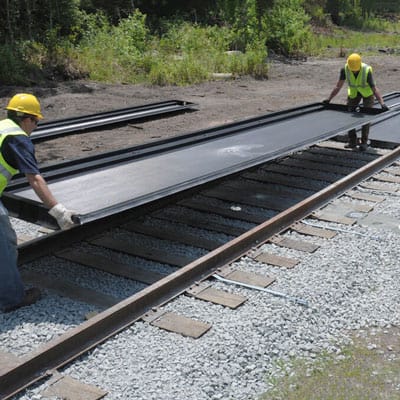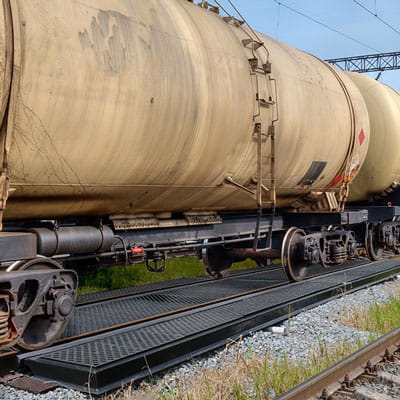When it comes to transporting hazardous materials, rail remains one of the most efficient and heavily used modes of freight in North America. Every day, tons of petroleum, chemicals, and industrial liquids move across the country by train. But with this efficiency comes risk, particularly when these materials are loaded and unloaded. Spills are not just likely; they’re inevitable. That’s where railroad track pans step into the spotlight.
In this blog, we’ll explore the crucial role railroad track pans play in spill response and containment. We’ll also take a closer look at how these systems support regulatory compliance and help protect our environment, all while keeping operations running smoothly. And if you’re ready to equip your rail site with top-notch spill solutions, we’ll tell you why Absorbents Online should be your first stop.
Why Are Spills at Rail Sites a Concern?
Rail yards and industrial facilities are hot zones for spill risks. The process of transferring liquids from railcars involves hoses, pumps, valves, and human operators. Whether it’s a slow drip or a full-blown rupture, the potential for environmental contamination is real.
Common spilled materials include:
- Diesel and jet fuel
- Hydraulic oils and lubricants
- Caustic chemicals and acids
- Solvents and waste liquids
Any of these substances can pose serious hazards to soil, groundwater, and stormwater systems. That’s why regulatory agencies like the EPA enforce strict rules around secondary containment and spill response.

What Are Railroad Track Pans?
Railroad track pans are modular containment systems installed between and alongside railroad tracks. Their primary job? To catch and contain any spilled liquids during the loading and unloading of railcars.
They are typically made from durable materials like:
- Polyethylene (resistant to most chemicals, lightweight)
- Galvanized or stainless steel (ideal for high-heat or heavy-duty applications)
These pans sit flush with the track bed and often feature grating on top so personnel can safely walk over them. The modular design allows them to be configured to any length, making them suitable for everything from single-car sidings to full-length industrial rail lines.
How Do Track Pans Enhance Spill Response?
Track pans are a frontline defense for any facility handling hazardous rail cargo. Here’s how they fit into a comprehensive spill response plan:
- Immediate Containment
When a leak or spill occurs, the pan captures the liquid before it can spread or seep into the ground. - Prevents Stormwater Contamination
Many systems feature sidewalls and covers to prevent rain from washing contaminants into drainage systems, a key concern for EPA compliance. - Reduces Cleanup Costs
Containing a spill at the source is far less expensive than remediating a contaminated site or paying for environmental damage. - Improves Worker Safety
Spilled liquids create slip hazards. Track pans with grated surfaces and fast drainage mitigate this risk. - Supports Spill Kit Effectiveness
By containing the fluid, track pans make it easier to deploy absorbents, booms, or vacuums for final cleanup.
Staying Compliant with EPA Regulations
The U.S. Environmental Protection Agency (EPA) mandates facilities to implement Spill Prevention, Control, and Countermeasure (SPCC) plans. These include the requirement for secondary containment systems when storing or transferring oils and hazardous substances.
Railroad track pans meet these criteria by:
- Serving as passive secondary containment
- Preventing discharge to navigable waters or adjoining shorelines
- Being compatible with stormwater management efforts
Failure to comply can result in hefty fines, damaged reputations, and long-term environmental liability. Investing in compliant solutions up front is both a regulatory and ethical imperative.

How Railroad Track Pans Integrate with Other Spill Containment Solutions
Track pans don’t operate in isolation, they’re part of a larger system of site safety and environmental control. Here’s how they work in tandem with other tools:
- Stormwater Protection: Use drain covers and filters at trackside storm drains to add a second layer of defense.
- Absorbents & Spill Kits: Deploy pads, socks, and booms in conjunction with pans to quickly mop up contained spills.
- Spill Berms & Dikes: Create larger containment areas around railcars or equipment using portable berms.
- Monitoring Systems: Some advanced track pan setups include leak sensors or alarms for early spill detection.
By integrating all these elements, facilities can build a robust and compliant spill prevention strategy.
Why Absorbents Online Is Your Go-To for Track Pans & Spill Gear
Choosing the right supplier matters. Absorbents Online offers a comprehensive selection of railroad track pans and related spill response products. Here’s why they stand out:
- Modular Designs: Easily configurable systems for short or long rail lines.
- Durable Materials: High-quality polyethylene and steel options built for harsh environments.
- EPA-Compliant Products: Meet or exceed all regulatory requirements.
- One-Stop Shop: Stock up on absorbents, containment berms, drain protectors, and more.
- Expert Support: Knowledgeable customer service to help you find the right solution for your site.
Whether you’re outfitting a new facility or upgrading an existing one, Absorbents Online makes it easy to protect your people, your property, and the planet.
Conclusion: Don’t Let Spills Derail Your Operations
Spills at rail sites are more than a mess, they’re a serious threat to the environment and your bottom line. Railroad track pans offer a proactive, practical solution to capture leaks before they become liabilities. When integrated with broader containment systems and backed by a trusted supplier like Absorbents Online, these tools empower facilities to meet compliance standards and protect vital infrastructure.Don’t wait for a spill to take action. Shop Absorbents Online today and equip your rail site with the best in spill containment solutions.